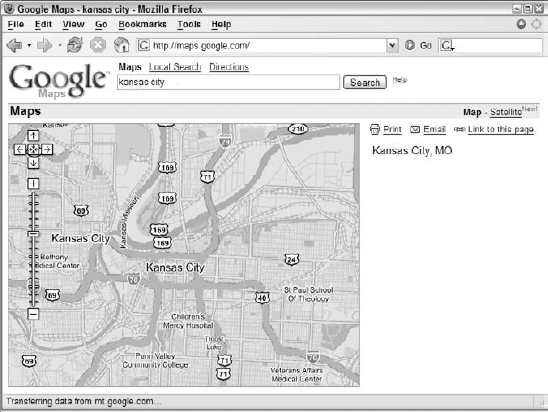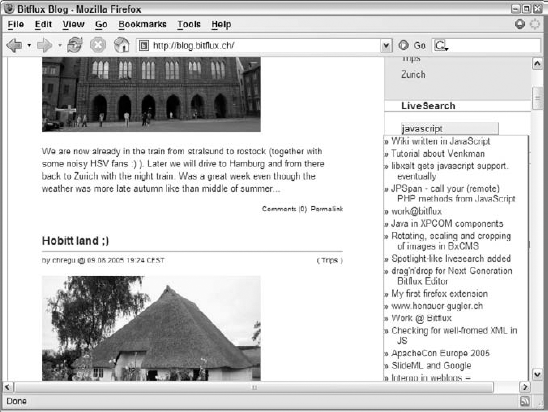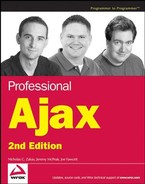1.6. Who Is Using Ajax?
A number of commercial web sites use Ajax techniques to improve their user experience. These sites are really more like web applications than traditional brochureware web sites that just display information because you visit it to accomplish a specific goal. The following are some of the more well-known and well-executed web applications that use Ajax.
1.6.1. Google Suggest
One of the first examples that developers cite when talking about Ajax is Google Suggest (www.google.com/webhp?complete=1). The interface is simply a clone of the main Google interface, which prominently features a text box to enter search terms. Everything appears to be the same until you start typing in the textbox. As you type, Google Suggest requests suggestions from the server, showing you a drop-down list of search terms that you may be interested in. Each suggestion is displayed with a number of results available for the given term to help you decide (see Figure 1-2).
This simple client-server interaction is very powerful and effective without being obtrusive to the user. The interface is responsive beyond what you may have learned to expect from a web application; it updates no matter how quickly you type and, as with autocomplete features in desktop software, you can use the up and down arrows to highlight and select each item in the suggestions list. Although still in beta, expect to see this approach make its way into the main Google page eventually.
Figure 1.2. Figure 1-2

1.6.2. Gmail
Gmail, Google's free e-mail service, has been raved about as a marvel of client-server interaction in the age of Ajax. When you first log in to Gmail, a user interface engine is loaded into one of the few iframes the application uses. All further requests back to the server occur through this user interface engine through an XMLHttp object. The data being transferred back and forth is JavaScript code, which makes for fast execution once downloaded by the browser. These requests serve as instructions to the user interface engine as to what should be updated on the screen.
Additionally, the Gmail application uses several frames and iframes to manage and cache big user interface changes. The extremely complicated use of frames enables Gmail to function properly with the Back and Forward buttons, which is one of the advantages of using frames or iframes instead of or in conjunction with XMLHttp (discussed later in the book).
The biggest win for Gmail is its usability. The user interface, as shown in Figure 1-3, is simple and uncluttered. Interaction with the user and communication with the server is all seamless. Once again, Google used Ajax to improve on an already simple concept to provide an exceptional user experience.
Figure 1.3. Figure 1-3

1.6.3. Google Maps
Another part of Google's dominant Ajax web applications is Google Maps (maps.google.com). Designed to compete with well-established mapping sites, Google Maps uses Ajax to avoid reloading its main page at all (see Figure 1-4).
Unlike other mapping web applications, Google Maps enables you to drag the map to move it in various directions. The dragging code is nothing new to JavaScript developers, but the tiling of the map and seemingly endless scrolling effect are another story. The map is broken up into a series of images that are tiled together to make the appearance of a contiguous image. The number of images used to display the map is finite, as creating new images every time the user moves the map would quickly lead to memory problems. Instead, the same images are used over and over to display different segments of the map.
The client-server communication is done through a hidden iframe. Whenever you do a search or ask for new directions, this information is submitted and returned within that iframe. The data returned is in XML format and is passed to a JavaScript function (the Ajax engine) to handle. This XML is then used in a variety of different ways: some is used to call the correct map images, and some is transformed using XSLT into HTML and displayed in the main window. The bottom line is that this complex Ajax application is, as of late 2006, the number two destination for mapping on the Web.
Figure 1.4. Figure 1-4

1.6.4. A9
Amazon.com is world famous for being an online marketplace for just about anything, but when it released a search engine, it did so with little fanfare and attention. The introduction of A9 (www.a9.com) showed off enhanced searching, enabling you to search different types of information simultaneously. For web and image searches it uses MSN to fetch results. It performs searches of books on Amazon.com and movies on IMDb (Internet Movie Database). Searches for Yellow Pages, Wikipedia, and Answers.com debuted in mid-2005.
What makes A9 unique is how its user interface works. When you perform a search, the different types of results are displayed in different areas of the page (see Figure 1-5).
On the search results page, you have the option of selecting other searches to perform using the same criteria. When you select a check box corresponding to a type of search, the search is performed behind the scenes using a combination of hidden iframes and XMLHttp. The user interface shifts to allow room for the extra search results, which are loaded as soon as they are received from the server. The result is a more responsive search results page that doesn't need to be reloaded when you want to search on different types of information.
Figure 1.5. Figure 1-5

1.6.5. Yahoo! News
Also introduced in 2005 was a new design for the Yahoo! News site (news.yahoo.com). The new design features an interesting enhancement: when you move your mouse over a particular headline, a small box pops up with a summary and, optionally, a photo associated with that story (see Figure 1-6).
The photo information and summary are retrieved from the server using XMLHttp and inserted into the page dynamically. This is a perfect example of how Ajax can be used to enhance a web page. Rather than making Ajax the primary usage mode, the Yahoo! News site is completely usable without Ajax; the Ajax functionality is used only to add a more responsive user experience in browsers that support it. Underneath is a semantically correct HTML page that is laid out logically even without CSS formatting.
Figure 1.6. Figure 1-6

1.6.6. Bitflux Blog
Another great example of using Ajax only as an enhancement is Bitflux Blog (blog.bitflux.ch), which features a technology called LiveSearch. LiveSearch works in conjunction with the search box on the site. As you type into the box, a list of possible search results is displayed immediately below (see Figure 1-7).
The search results are retrieved using XMLHttp as an HTML string that is then inserted into the page. You can search the site the old-fashioned way as well: by filling in the text box and pressing Enter. The LiveSearch Ajax functionality is just an enhancement to the overall site and isn't required to search.
Figure 1.7. Figure 1-7

